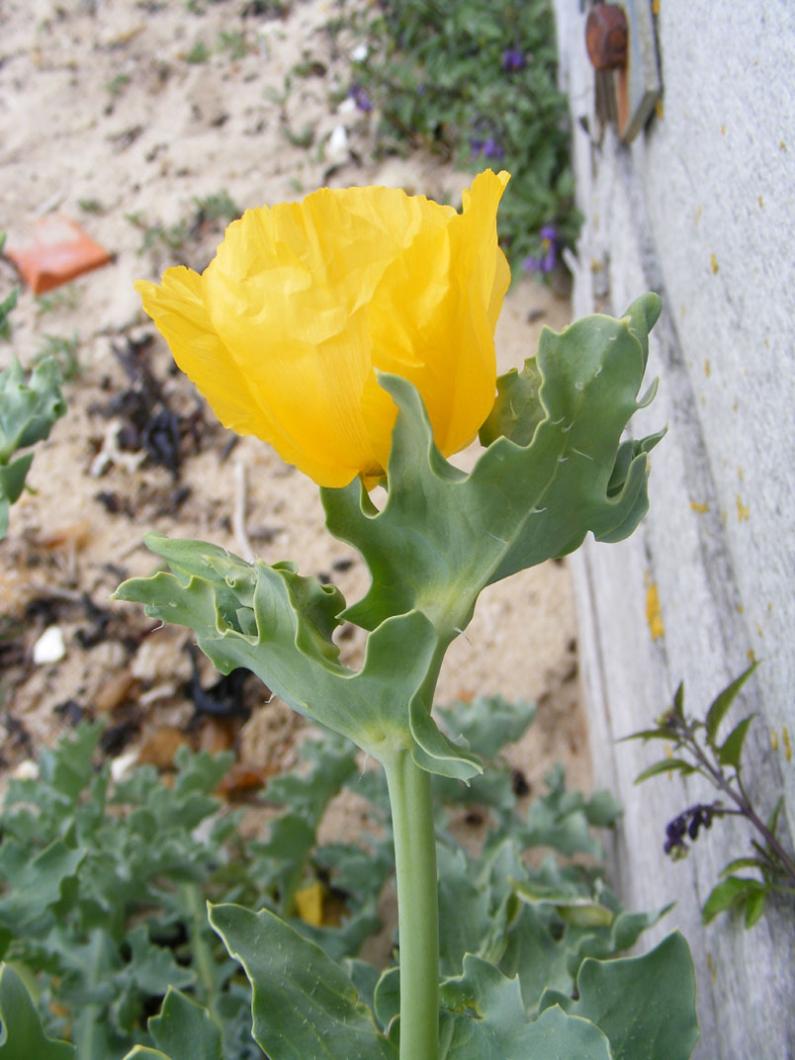You could blame the devil for spawning this horned plant.
Or you could hold Thomas Jefferson responsible for its appearance on America’s eastern beaches. In 1807, he planted its seeds at Monticello “in an oval bed southeast of the house.” No matter whom you fault, the mellow yellow blooms of the horned poppy are on our beaches to stay.
Yellow horned poppy might be considered a satanic species, since this non-native plant has gained a root hold at a seashore near you. Recently seen on Cape Pogue and East Chop Drive beach, horned poppy, also known as sea poppy, has situated itself in the sand to stay.
A great description of this beach-stayer came from 16th century herbalist John Gerard, who described this peculiar plant in the following way: “The yellow horned poppy hath whitish leaves very much cut or jagged, somewhat like the leaves of garden Poppie, but rougher and more hairie. The stalks be long, round, and brittle. The floures be large and yellow, consisting of foure leaves; which being past, there come long huskes or cods, crooked like an horn or cornet, wherein is conteined small black seede. The roote is great, thicke, scalie, and rough, continuing long.”
In plain English, look on the dunes for the yellow flowers that resemble large buttercups, and pods that might remind you of string beans. These long, sickle-shaped pods are likely the reason for their name.
Its flowers last only one day, but seem to bloom continuously as one will follow another. The plant, which blossoms in its second season, rarely lives longer than five years.
In that short time, though, sea poppy can do some damage. Delirium and even death may befall those that dare to dabble. This poppy is in the Papavaraceau family, same as the more well-known opium poppy, and is reported to be toxic, causing respiratory failure and subsequent death.
According to some, sea poppy, like its relatives, is also psychoactive. One account from the British Royal Society in 1698 reported that “a man mistook this plant for that of sea holly or eryngoes. He baked the root in a pie and ate it hot, whereupon he became a victim of its hallucinatory and cathartic actions and mistook the content of his chamber pot for gold!”
While sea poppy won’t make you rich, it does have other virtues. Writing in the 17th century, Nicholas Culpeper sang its medicinal praises: “It is under the Sun in Leo; and is aperitive and cleansing, opening obstructions of the spleen and liver, and of great use in curing the jaundice and scurvy: some reckon it cordial, and a good antidote against the plague. Some quantity of it is put into aqua mirabilis. Outwardly it is used for sore eyes, to dry up the rheum, and take away specks and films, as also against tetters and ringworms, and scurfy breakings-out. The root dried and powdered, is a galsamic and sub-astringent. It is given against bloody-fluxes, and in other hæmorrhages, half a drachm for a dose.”
The contradiction of death and euphoria provides a challenge and a dare for those who might have a predilection for poppy. How much to use is an important question, one that you wouldn’t want to get wrong. No advice is forthcoming: we all know that the devil is in the details.
Suzan Bellincampi is director of the Felix Neck Wildlife Sanctuary in Edgartown.




Comments
Comment policy »